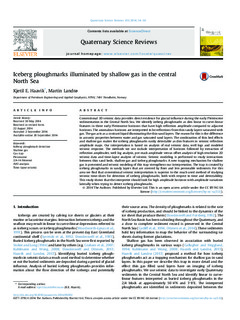| dc.contributor.author | Haavik, Kjetil Eik | |
| dc.contributor.author | Landrø, Martin | |
| dc.date.accessioned | 2016-11-28T10:18:58Z | |
| dc.date.accessioned | 2017-01-18T08:50:45Z | |
| dc.date.available | 2016-11-28T10:18:58Z | |
| dc.date.available | 2017-01-18T08:50:45Z | |
| dc.date.issued | 2014 | |
| dc.identifier.citation | Quaternary Science Reviews 2014, 103:34-50 | nb_NO |
| dc.identifier.issn | 0277-3791 | |
| dc.identifier.uri | http://hdl.handle.net/11250/2427596 | |
| dc.description.abstract | Conventional 3D seismic data provides direct evidence for glacial influence during the early Pleistocenesedimentation in the Central North Sea. We identify iceberg ploughmarks as dim linear to curve-linearfeatures in three early Pleistocene horizons that have high reflection amplitude compared to adjacenthorizons. The anomalous horizons are interpreted to be reflections from thin sandy layers saturated withgas. The gas acts as a contrast liquid illuminating the thin sand layers. The reason for this is the differencein acoustic properties between water and gas saturated sand layers. The combination of thin bed effectsand shallow gas makes the iceberg ploughmarks easily detectable as dim features in seismic reflectionamplitude maps. Our interpretation is based on analysis of real seismic data, well logs and modeledseismic response. The methods we use include interpretation of horizons followed by extraction ofreflection amplitudes, well log analysis, pre-stack amplitude versus offset analysis of high resolution 2Dseismic data and time-lapse analysis of seismic. Seismic modeling is performed to study interactionsbetween thin sand beds, shallow gas and iceberg ploughmarks. A new trapping mechanism for shallowgas is presented and seismic modeling of this trap strengthens our interpretation. The trap is created byiceberg ploughmarks in sandy layers that are covered byfiner and less permeable sediments. For thisarea wefind that conventional seismic interpretation is superior to the much used method of studyingseismic time-slices for detection of iceberg ploughmarks, both with respect to time and detectability.This study shows that the interpreter should look for high amplitude horizons with amplitude variationslaterally when trying to detect iceberg ploughmarks. | nb_NO |
| dc.language.iso | eng | nb_NO |
| dc.publisher | Elsevier | nb_NO |
| dc.rights | Navngivelse-Ikkekommersiell-DelPåSammeVilkår 4.0 Internasjonal | * |
| dc.rights.uri | http://creativecommons.org/licenses/by-nc-sa/4.0/deed.no | * |
| dc.title | Iceberg ploughmarks illuminated by shallow gas in the central North Sea | nb_NO |
| dc.type | Journal article | nb_NO |
| dc.type | Peer reviewed | nb_NO |
| dc.date.updated | 2016-11-28T10:18:58Z | |
| dc.source.pagenumber | 34-50 | nb_NO |
| dc.source.volume | 103 | nb_NO |
| dc.source.journal | Quaternary Science Reviews | nb_NO |
| dc.identifier.doi | 10.1016/j.quascirev.2014.09.002 | |
| dc.identifier.cristin | 1187284 | |
| dc.description.localcode | ©2014 The Authors. Published by Elsevier Ltd. This is an open access article under the CC BY-NC-SAlicense (http://creativecommons.org/licenses/by-nc-sa/3.0/) | nb_NO |

